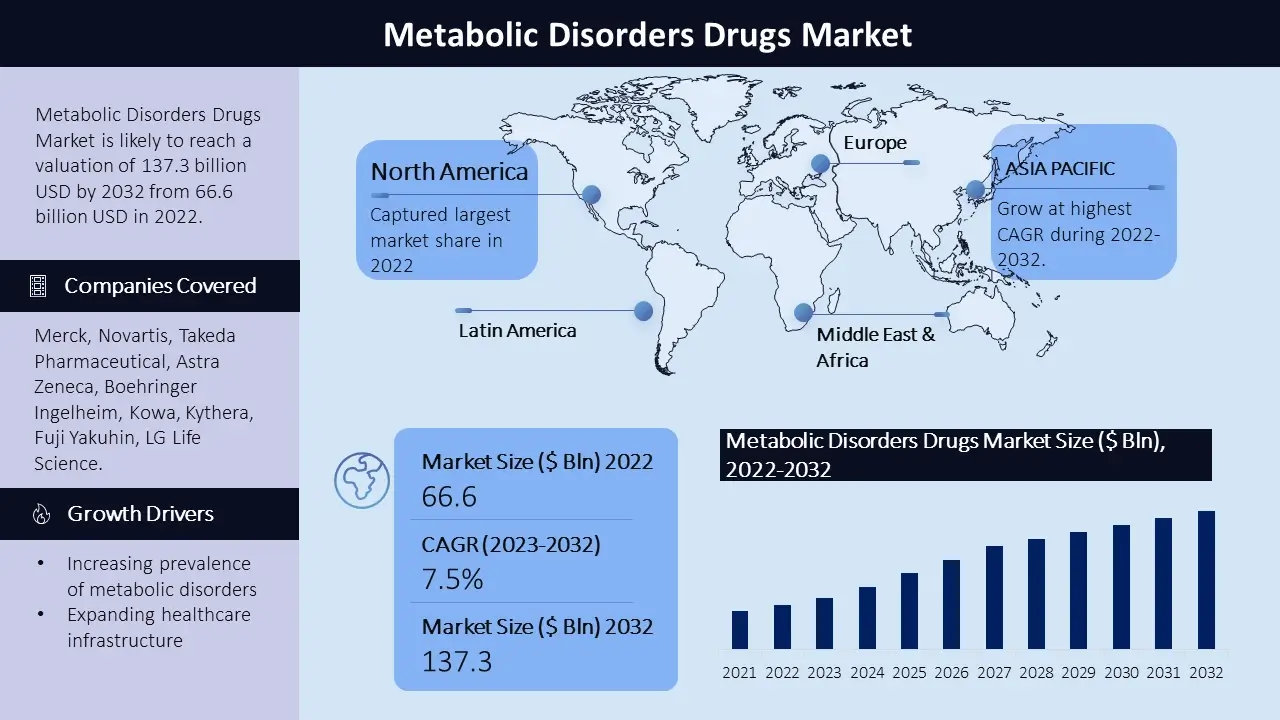Metabolic Disorders Drugs Market By Type (Glycogen Metabolism Disease Drug, Lipid Metabolism Disease Drug, Amino Acid Metabolism Drug, Other), By Application (Lysosomal Storage Diseases, Diabetes, Obesity, Inherited Metabolic Disorders, Hypercholesterolemia), By End-users (Hospital, Retail Pharmacy) And By Geographic Regions (North America, Europe, Asia Pacific, Latin America, Middle East and Africa) – Global Market Analysis, Trends, Opportunity and Forecast, 2023-2032
Metabolic Disorders Drugs Market Size and Overview
The metabolic disorders drugs market size is poised to reach USD 137.3 billion by the end of 2032, growing at a CAGR of 7.5% during the forecast period, i.e., 2023 – 2032. In the year 2022, the industry size of metabolic disorders drugs market was USD 66.6 billion. The reason behind the growth can be attributed to the increasing occurrence of metabolic disorders, along with diabetes and obesity, the increasing healthcare infrastructure, especially in growing areas, increasing attention on research and improvement and the advent of telemedicine and digital health resolutions has transformed the marketplace panorama. The marketplace incorporates a wide range of products. The market is highly competitive with key players striving to meet evolving customer demands.
Metabolic Disorders Drugs Market: Report Scope |
|
|
Base Year Market Size |
2022 |
|
Forecast Year Market Size |
2023-2032 |
|
CAGR Value |
7.5% |
|
Segmentation |
|
|
Challenges |
|
|
Growth Drivers |
|
Metabolic Disorders Drugs Market Segmentation
By Type
- Glycogen Metabolism Disease Drug
- Lipid Metabolism Disease Drug
- Amino Acid Metabolism Drug
- Other
By Application
- Lysosomal Storage Diseases
- Diabetes
- Obesity
- Inherited Metabolic Disorders
- Hypercholesterolemia
By End-users
- Hospital
- Retail Pharmacy
By Geographic
- North America
- Europe
- Asia Pacific
- Latin America
- Middle East and Africa
On the basis of type in the metabolic disorder’s drugs market the lipid metabolism disease drug segment accounted the highest market share in 2022. The segment of lipid metabolism disease drug holds the highest market share, in the market for drugs targeting metabolic disorders. This dominance stems from the rising occurrence of lipid disorders like hypercholesterolemia and hypertriglyceridemia which're contributors to heart disease and stroke. As a result, there is an increasing demand for treatment choices, in this area.
Metabolic Disorders Drugs Market Regional Analysis
North America stands as one of the major markets for metabolic disorders drugs, driven through the high prevalence of metabolic disorders. Additionally, presence of key market players makes contributions to the region’s dominance. The United States, primarily, is a key contributor on this marketplace. Europe is one of the leading marketplaces for metabolic disorders drugs because of the region’s mix of hospital and retail pharmacy users. The European market showcases a developing interest in personalized medicine, fueled by advancements in technology. The Asia Pacific metabolic disorders drugs market is estimated to witness significant growth, during the forecast timeframe led by, rapid urbanization, changing lifestyles, and increasing healthcare expenditure. The demand for metabolic disorders drugs is anticipated to rise in countries like China and India, given their large populations and rising burden of metabolic disorders. Latin America and the Middle East and Africa display steady growth inside the metabolic disorders drugs market, fueled via growing middle class and increasing awareness about metabolic disorders in these regions. Key participants to the market's growth in these areas encompass Brazil, Mexico, the United Arab Emirates, and South Africa.
Metabolic Disorders Drugs Market Growth Drivers
The growing prevalence of metabolic problems, inclusive of diabetes and obesity, propel the demand for effective and dependable drugs. Additionally, improvements in technology have brought about the improvement of personalized medicinal drug and centered treatments, attracting healthcare carriers and sufferers alike. The growing geriatric population and sedentary life also contribute to market rise, as those factors grow the hazard of metabolic issues. The growing healthcare infrastructure, particularly in growing regions, drives the demand for metabolic disease drugs. Healthcare carriers require powerful treatments to control the developing burden of metabolic problems, boosting the income of drugs inclusive of insulin and oral hypoglycemic suppliers. The increasing awareness on research and development activities offers massive increase potential. Key market companies are investing in research to develop revolutionary medications and treatments for metabolic issues, catering to various affected person desires. This manner is expected to keep, because the demand for powerful and customized treatments will increase. The arrival of telemedicine and digital health solutions has converted the market panorama. These technologies augment patient engagement, improve treatment adherence, and provide actual-time tracking, driving marketplace increase.
Metabolic Disorders Drugs Market Challenges
High cost of drugs and stringent regulatory requirements are hindering the growth of market. In developing regions, this factor has resulted in limited demand for product. Moreover, the increasing prevalence of counterfeit drugs is also restricting the growth of market.

Metabolic Disorders Drugs Market Key Companies
The metabolic disorders drugs market is poised by several main corporations, each making big contributions to the industry through their sturdy market presence and progressive product offerings. Among these principal players are Merck, Novartis, Takeda Pharmaceutical, Astra Zeneca, Boehringer Ingelheim, Kowa, Kythera, Fuji Yakuhin, LG Life Science, and Mitsubishi Tanabe Pharma, AbbVie, Actelion Pharmaceuticals, Amgen and other players. These essential players constantly try and revamp their marketplace percentage and meet the desires of a diverse investor base. Their competitive techniques encompass product innovation, forging strategic partnerships, undertaking mergers and acquisitions, and increasing their distribution networks.
In March 2023, Merck announced that it had received FDA approval for its new drug, Keytruda, for the treatment of advanced melanoma.
In February 2023, Novartis announced that it had reached an agreement to acquire the gene therapy company, AveXis, for $8.7 billion.

Need Customized Report for Your Business ?
Utilize the Power of Customized Research Aligned with Your Business Goals
Request for Customized Report- Quick Contact -
- ISO Certified Logo -

















